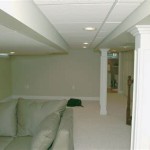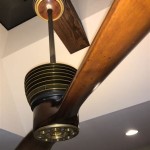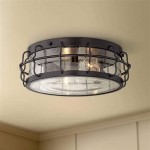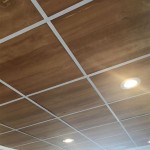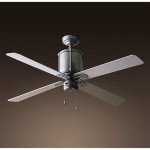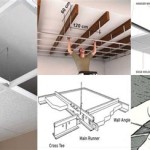Awesome Ceiling Fans To Keep You Cool In Summer
As summer temperatures rise, maintaining a comfortable indoor environment becomes a priority. While air conditioning units are effective, they can also be energy-intensive and lead to higher electricity bills. Ceiling fans offer a practical and energy-efficient alternative, circulating air and creating a perceived cooling effect. This effect is achieved through the breeze generated by the fan, which evaporates moisture from the skin, resulting in a cooler sensation. Selecting the appropriate ceiling fan requires careful consideration of various factors, including room size, blade design, motor type, and aesthetic preferences. Choosing wisely can significantly enhance comfort levels throughout the summer months while optimizing energy consumption.
The market offers a diverse range of ceiling fans, each designed to cater to specific needs and preferences. From basic models focused on functionality to more elaborate designs incorporating advanced features, the options are extensive. Understanding the key characteristics of different fan types is crucial for making an informed decision that aligns with individual requirements and budget constraints. Factors such as blade pitch, fan speed settings, and the availability of remote controls can significantly impact the overall performance and convenience of the appliance.
Understanding the Key Features of Ceiling Fans
Ceiling fans are more than just decorative fixtures; they are functional appliances that play a significant role in indoor climate control. To select a ceiling fan that effectively addresses cooling needs, one needs to understand the key features that define its performance. These features include the fan's size, blade pitch, motor type, and control options. Each of these factors contributes to the fan's ability to circulate air efficiently and effectively.
Fan Size: Determining the appropriate fan size is paramount for optimal performance. The correct size is directly related to the room's dimensions. A fan that is too small will struggle to effectively circulate air throughout the space, while a fan that is too large can create an uncomfortable draft and may be visually overwhelming. Generally, rooms smaller than 75 square feet benefit from fans with a blade span of 36 inches or less. Rooms ranging from 75 to 144 square feet require a 42-inch fan. For spaces between 144 and 225 square feet, a 52-inch fan is generally recommended. Larger rooms, exceeding 225 square feet, may necessitate fans with blade spans of 56 inches or greater, or the use of multiple fans strategically placed throughout the room. Accurately assessing the room’s dimensions before purchasing a fan is crucial for ensuring its efficient and effective operation.
Blade Pitch: The blade pitch, referring to the angle of the fan blades, significantly influences the fan's ability to move air. A steeper blade pitch generally results in greater air movement, creating a stronger cooling effect. However, a steeper pitch also requires more power to operate, potentially increasing energy consumption. Conversely, a shallower blade pitch will move less air but consume less energy. The ideal blade pitch is a balance between performance and efficiency, typically ranging from 12 to 15 degrees. Consumers should consider the trade-offs between air movement and energy consumption when selecting a fan with a specific blade pitch.
Motor Type: The motor is the heart of the ceiling fan, determining its power, efficiency, and lifespan. There are primarily two types of motors used in ceiling fans: AC (Alternating Current) and DC (Direct Current). AC motors are the more traditional type, generally less expensive but also less energy-efficient and noisier than DC motors. DC motors, while initially more expensive, offer significant advantages in terms of energy efficiency, quieter operation, and often a greater range of speed settings. Over the lifespan of the fan, the energy savings from a DC motor can often offset the initial cost difference. Furthermore, DC motors are typically more durable and have a longer lifespan than their AC counterparts. When choosing a ceiling fan, the motor type is a critical factor to consider, balancing initial cost with long-term performance and energy efficiency.
Control Options: The control options for a ceiling fan determine how the fan's speed and lighting (if applicable) are adjusted. The most common control options include pull chains, wall controls, and remote controls. Pull chains are the simplest and most basic control method, offering a limited number of speed settings. Wall controls provide a more integrated and convenient solution, often allowing for more precise speed adjustments and separate control of the fan and light. Remote controls offer the greatest flexibility and convenience, allowing users to adjust the fan's settings from anywhere in the room. Some advanced remote controls also offer features such as timers and programmed settings. The choice of control option depends on individual preferences and the desired level of convenience.
In summary, selecting a ceiling fan requires careful consideration of its size, blade pitch, motor type, and control options. These features collectively determine the fan's performance, efficiency, and convenience. By understanding the nuances of each feature, consumers can make an informed decision and choose a ceiling fan that effectively meets their cooling needs while optimizing energy consumption.
Choosing the Right Ceiling Fan for Different Room Types
The optimal ceiling fan selection varies depending on the specific room it is intended for. Factors such as room size, ceiling height, and the room's primary function all play a significant role in determining the appropriate fan type. A fan that performs well in a living room may not be suitable for a bedroom or a kitchen. Therefore, considering the unique characteristics of each room is essential for maximizing the fan's effectiveness and ensuring user satisfaction.
Living Rooms: Living rooms are typically larger spaces that require fans capable of generating significant airflow. Given their size, fans with blade spans of 52 inches or greater are often recommended. The aesthetic design of the fan is also crucial in living rooms, as the fan often serves as a focal point in the space. A wide variety of styles and finishes are available, allowing homeowners to choose a fan that complements their existing décor. Features such as integrated lighting are also highly desirable in living rooms, providing both illumination and air circulation. Consider models with dimmable lights to adjust the brightness based on the time of day and the specific activity. For high ceilings, a downrod extension may be necessary to ensure that the fan is positioned at the optimal height for effective air circulation.
Bedrooms: Bedrooms prioritize quiet operation to avoid disrupting sleep. DC motor fans are particularly well-suited for bedrooms due to their significantly quieter performance compared to AC motors. A fan with a remote control is also a convenient feature in bedrooms, allowing users to adjust the fan's speed and lighting from the comfort of their bed. The size of the fan should be appropriate for the size of the room, typically ranging from 42 to 52 inches for most bedrooms. Consider models with sleep timers that automatically turn off the fan after a set period, further promoting energy efficiency. Darker finishes and understated designs often work well in bedrooms, creating a relaxing and calming atmosphere.
Kitchens: Kitchens present unique challenges due to the presence of heat and moisture. Fans designed specifically for damp locations are essential in kitchens to prevent damage from humidity. Models with sealed motors and rust-resistant finishes are highly recommended. Due to potential grease and grime, blades that are easy to clean are an advantage. Integrated lighting is also crucial in kitchens, providing task lighting for food preparation. Consider choosing a fan with bright, efficient LED lighting to illuminate the workspace effectively. The size of the fan should be appropriate for the kitchen’s dimensions, typically ranging from 42 to 52 inches. Ensure that the fan is positioned to avoid interference with light fixtures or cabinet doors.
Bathrooms: Similar to kitchens, bathrooms require fans designed for damp locations. Look for models specifically labeled as "damp-rated" or "wet-rated" to ensure safe and reliable operation in humid environments. In addition to air circulation, bathroom fans also play a crucial role in moisture removal, helping to prevent mold and mildew growth. Consider models with a powerful motor and blades designed for maximum airflow. Integrated lighting is also a desirable feature in bathrooms, providing illumination for grooming and other tasks. Compact fans with a blade span of 36 to 42 inches are typically sufficient for most bathrooms. Ensure that the fan is properly wired and installed according to local electrical codes.
In conclusion, selecting the right ceiling fan for different room types requires careful consideration of the room's size, environment, and intended use. By choosing a fan that is specifically designed for the unique characteristics of each room, homeowners can maximize its effectiveness and enjoy a comfortable and well-ventilated living space.
Maximizing the Energy Efficiency of Ceiling Fans
Ceiling fans are inherently more energy-efficient than air conditioning units, but their energy consumption can be further optimized through mindful usage and maintenance. By adopting simple strategies, homeowners can significantly reduce their energy bills while enjoying the cooling benefits of ceiling fans. These strategies include adjusting fan speed, utilizing seasonal settings, and performing regular maintenance.
Adjusting Fan Speed: Running a ceiling fan at its highest speed consumes more energy than operating it at a lower speed. In many cases, a lower speed setting is sufficient to create a comfortable breeze and circulate air effectively. Experiment with different speed settings to find the optimal balance between cooling comfort and energy consumption. During cooler evenings or when fewer people are in the room, a lower speed setting is often adequate. Using the fan's lowest effective speed setting can significantly reduce energy consumption over time.
Utilizing Seasonal Settings: Most ceiling fans have a switch that allows users to reverse the direction of the blade rotation. During the summer months, the fan should rotate counter-clockwise (when viewed from below) to create a downward breeze that cools the skin. During the winter months, the fan should rotate clockwise at a low speed to gently circulate warm air that rises to the ceiling, helping to distribute it throughout the room. Utilizing this seasonal setting can contribute to significant energy savings by reducing the workload on the heating system.
Regular Maintenance: Dust accumulation on ceiling fan blades can reduce their efficiency and increase energy consumption. Regularly cleaning the blades with a damp cloth or duster will ensure that the fan operates at its optimal performance level. Additionally, check the fan's mounting hardware periodically to ensure that it is securely attached to the ceiling. Loose connections can cause the fan to wobble, which can be both noisy and potentially dangerous. Tightening any loose screws or bolts will help to maintain the fan's stability and prevent any potential safety hazards. Also, lubricating the motor (if applicable, consult the manufacturer's instructions) can reduce friction and improve its efficiency.
Turn Off When Leaving the Room: Ceiling fans cool people, not rooms. A ceiling fan does not lower the temperature of a room; it merely circulates the air, creating a breeze that evaporates moisture from the skin and produces a cooling sensation. Therefore, it is crucial to turn off the fan when leaving the room to avoid wasting energy. Leaving a fan running in an empty room provides no benefit and only contributes to unnecessary energy consumption. Consider installing smart home devices that automatically turn off the fan when no one is present.
By implementing these energy-saving strategies, homeowners can maximize the efficiency of their ceiling fans and reduce their energy bills without sacrificing cooling comfort. Mindful usage and regular maintenance are key to unlocking the full potential of ceiling fans as an energy-efficient alternative to air conditioning.

Check Out The 10 Best Inverter Fans To Buy In 2024 Mint

10 Best Ceiling Fans Top To Keep You Cool
Install A Ceiling Fan To Keep You Cool

Best V Guard Fans To Keep You Cool All Year Round Top 7 Picks Mint

How To For A Ceiling Fan Reviews By Wirecutter

Ceiling Fan Direction For Summer Set It To Turn This Way

Outdoor Ceiling Fans The Home Depot

Beat The Summer Heat For As Little 3 Hour

7 Top Rated Ceiling Fans To Consider This Year

10 Cute Ceiling Fans Including Best For Bedroom
Related Posts

